Introduction.
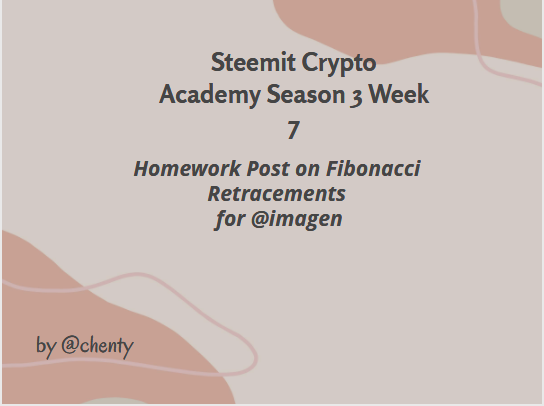
I am very excited to be a part of professor @imagen's class this week on Fibonacci retracements.
I would now present my answers to the questions given.

Who Was Fibonacci?

Leonardo Pisano Fibonacci popularly called Fibonacci is a famous man in the mathematics world known for his several important contributions to mathematics.
Fibonacci is an Italian born in the year 1170 born to the Bonacci family.
Fibonacci was a traveler and so was called Bigollo meaning good for nothing or a traveller.
His father Guilielmo worked in Pisa in North Africa and so Fibonacci schooled there. He was taught mainly mathematics in a town called Bugia where the people of Pisa did their trading.
He immediately fell in love with mathematics as he realized how important it was to Pisa, Bugia and the countries he and his father travelled to the extent that he stated in his book Liber abaci that "as a child his father took him to Bugia where he studied the art of India's 9 symbols".
Fibonacci's travels came to an end in 1200. He went back to Pisa and made useful notes which helped to revive the interest and importance of the ancient mathematical symbols, skills, among others.
Aside the Liber abaci, Fibonacci wrote more books; Practica gometriae, Flos, etc.
All these books can still be obtained in hard copy with the writing of Fibonacci. However, writings on his book Di minor guisa, etc cannot be found.
The works of Fibonacci were so good that he gained recognition from the holy roman emperor Frederick II. Members of the court of Frederick II submitted problems to Fibonacci but he wowed them by solving all where in his Flos, he has detailed the problems and their solutions.
Another good achievement of Fibonacci was being awarded a salary in Pisa for being a "serious and learned master" and giving accounting solutions to the city.

Fibonacci's Most Important Contributions In The Field Of Mathematics.
- Liber Abaci.
One of the most contributions of Fibonacci is the Liber Abaci; method of Indians.
This method is also called the modus information and known today as the Hindu-Arabic numeral system.
The Liber Abaci is a book by Fibonacci first published in 1202 but the original copy of the book is not known to be in existence.
The Liber Abaci which explained the practical use of the new numerical Hindu-Arabic system was a well received book across Europe as it was applied in several aspects of their life with the most important being trading.
Other areas of application includes book keeping, measures of calculations, etc.
The original 1202 copy like already stated is not known to exist anymore but there's a 1228 copy of the Liber Abaci.
The 1202 copy has been divided into 2 parts; first section and second section.
The first section talks about the numerical Hindi-Arabic system. It talks about it's nature, uses and applications of the Hindi Arabic system. It also compares it with the Roman numerals, etc.
One reason why Europe was excited about this Liber Abaci was that its first section explained how traders could transactions faster and with ease by using abacus.
The second section of the Fibonacci's Liber Abaci is quite straightforward as it deals with conversion of currencies from 1 to another and calculation of profits.
The book is not limited to just the Hindu-Arabic numerical system but also talks about prime numbers and irrational numbers.
- Fibonacci Sequence.
The Fibonacci sequence is another important contribution of Fibonacci to the mathematical world.
This contribution is known as a sequence of numbers. In this sequence, each number is the sum of the previous 2 numbers.
However, Fibonacci in his sequence didn't start from 0 but rather 1 and continued in the order of the addition of the 2 previous numbers.
This means the next number after 1 was 1 then 2, 3,5,7,8, 13,21...233. But other sources believe the numbers start from 0 followed by 1,1,2,3,5...233.
Although Fibonacci initially ended at 233, there has been another work that has carried it to 377.

The Golden Ratio, Where It Is Obtained, Where It Is Located And Application Through History.
Description And How The Golden Ratio Is Obtained.
The Golden ratio is a mathematical concept that has been in existence even at the time of the ancient Greek days.
It is the number phi. Golden ratio is the ratio of the line segment cut into two different pieces of different lengths such that the ratio of a whole segment to that of the longer segment is equal to the ratio of the longer segment to the shorter segment.
This definition above means that, a line is divided into 2 parts where the longer part divided by the smaller part equals the sum of the 2 sides divided by the longer part that is equal to 1.618. Hence, the value of phi=1.618...
This concept was first described by Euclid a Greek mathematician.
The golden ratio is associated to the Fibonacci sequence which I have already in the paragraphs above. It is associated in the sense that when you take the ratio of successive Fibonacci figures, you get closer to phi figure 1.618...
When you try to reverse the Fibonacci digits by extending backwards, you will be entering into the negative numbers and hence the ratio of those negative Fibonacci digits would take you close to the negative phi value -0.6180...
It should be noted that the golden ratio or phi value is obtained from the representing golden ratio as a quadratic equation; x2 – x – 1=0.
Solving this equation with the Fibonacci sequence results in a positive solution ( 1 + √5)/2 ) = 1.618... and a negative solution ( 1 - √5)/2 ) = -0.6180...
Where The Golden Ratio Is Located Or Where It Exists.
The Golden ratio is located in a lot of places right from geometric figures, animals, plants and even in humans. I would give a few of them below;
- The human and animal body parts.
The human body parts and animal body parts is an example of where the golden ratio can be located.

An example of the golden ratio in the human body is the length of the index finger and the distance from the tip of the finger to the knuckle. Another example is the total length of the skeleton to the length of the navel.
- Rectangular shapes.
Another example where the golden ratio can be seen is in rectangular shapes. These include playing cards, book covers, etc. Golden ratio rectangles are therefore called golden rectangles.

The knowledge from golden rectangles have been applied in several fields like in the works of Leonardo da Vinci.
- Petals.
Flower petals are also a good example of where the golden ratio can be found. An example is seen in the rose flower.

In the rose flower, new roses grow on top of the previous ones which is the case in the Fibonacci numbers as new numbers are a sum of the previous 2.
In this case it shows that new petals are dependent on the previous ones and has it been proven that when you take measurements of 2 adjacent rose petals and do the phi analysis, you should get the phi value of 1.618.
- The human face.

The human face is another place the golden ratio occurs. It is seen here between the mouth, eyes and nose.
- **Fruits, vegetables, trees, seed heads and shells.
The patterns of fruits like pineapples are in spiral arrangement similar to the Fibonacci numbers while trees display Fibonacci numbers 3 and 5.

Seed heads are also in spiral patterns while shells follow a logarithmic spiral exhibiting the golden ratio.

Application of Golden Ratio Through History.
The Golden Ratio is applied in music, paintings and drawings, architecture and buildings etc. Leonardo Da Vinci is known to have used it severally in his paintings including the famous Monalisa.

How Fibonacci Is Used In TradingView.
- Launch tradingview and click on chart.

- Choose the cryptocurrency you want to analyze. I chose DOGE/USDT.

- On the left side of the chart, there is a toolbox.

- Select the third tool; Gann and Fibonacci tools.
- Click on Fib retracement.

- Now to use the fib retracement tool, you must first check if your chart is in uptrend or downtrend. If the chart is in uptrend, you draw the line from bottom to top of chart but if it's in downtrend you draw from top to bottom of chart.
My DOGE/USDT chart is in downtrend so I draw the line from top to bottom of the chart.

- Once these lines are drawn with their various indications and meanings, you can start analyzing.

An Investment In Doge/USDT And Analysis At Time Of Buying, 24 Hour And 48 Hour Fibonacci Retracement Analysis.
- Login in to exchange or wallet to make investment. I logged into my huobi account.

- At the top left side of the screen, search for the currency you want to invest in. In my case doge.
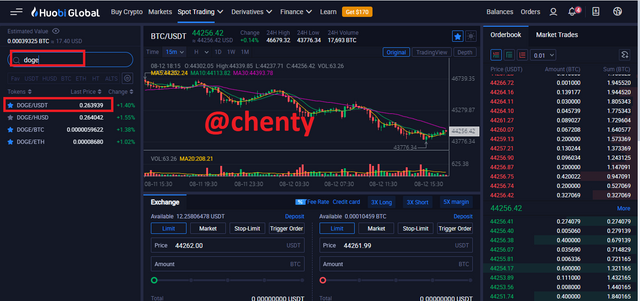
- In the buy doge section location at the bottom of the page, input the amount of doge you want to buy. In my case I keyed in 40 doge which corresponds to 10.574 usdt.
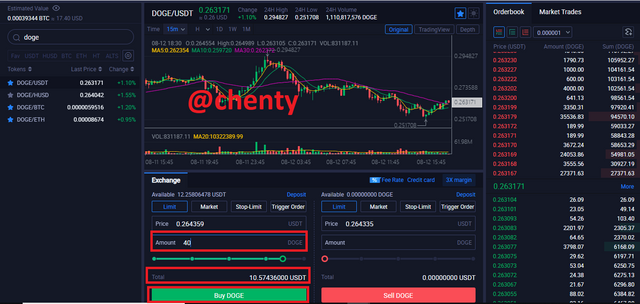
- Click on buy doge. Doge was bought but due to fees received 39.92 doge
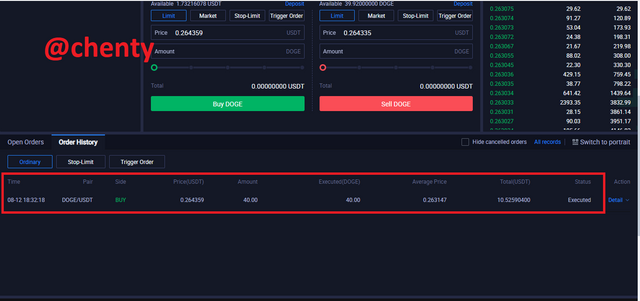
39.92 Doge bought at 18:32 on the 12th of August 2021.
I made my investment at 0.264359 per doge.
The overall trend is downtrend but at the point I made the investment there was a likely trend reversal or retracement.

At the price at which I made the investment, the reversal level was 0.236 ($0.140032), next reversal at 0.382($0.253261),next at 0.5($0.344775).
I made my investment at around the 0.382 retracement slightly above that point.
After 24 hours,
After I made my purchase, I noticed after 24 hours that the chart started to move in an uptrend.
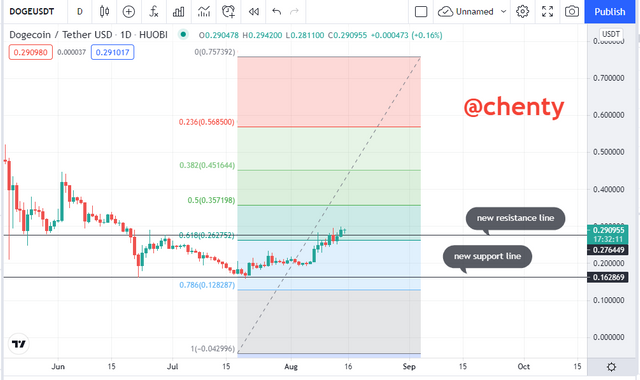
The 0.786 retracement became the new support line and 0.618 became my new resistance line as shown.
The price after 24 hours was $0.278069 and the value of my assets increased to $11.094.
After 48 hours.
The value of my assets continued in an uptrend after 48 hours and so I expected to make more on my investment.
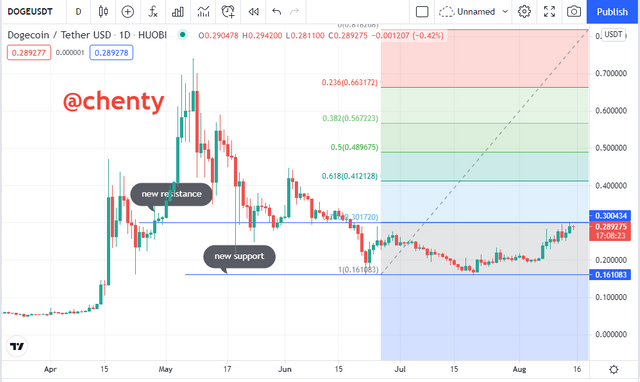
The 1 fib retracement became my new support line at $0.1628 and the 0.7836 was my new resistance at 0.3000.
It should be noted that I made this analysis some hours after the 48 hour actual time I bought DOGE asset and so might not be 100% accurate.
The value after 48 hours was $0.28911 and my new investment increased to $11.54.


Fibonacci extentions.
Fibonacci extensions works on the principle of the Fibonacci sequence user by traders to identify support and resistance levels.
They are points at which prices of assets might reverse expressed in percentages. They therefore show price levels.
The common extension levels used are 161.8%, 261.8%. Other extensions levels used are 61.8%, 100%, 200%.
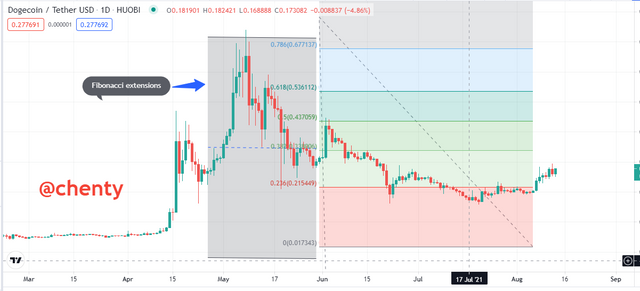
Fibonacci extensions are important because they can tell us where support and resistance are when other indicators or methods of analysis cannot.

Conclusion.
I must say a big thank you to professor @imagen for this informative lecture.
Fibonacci was a man known for his great contributions to the world of mathematics with the introduction of the Fibonacci sequence, the golden ratio among others.
The golden ratio occurs in a lot of places including plants, the human parts and face, seed shells, etc.
The golden ratio has also been applied in architectural and painting works notably in the works of Leonardo Davinci.
Another great achievements of Fibonacci is the application of the Fibonacci sequence in trading by using the Fibonacci retracements and Fibonacci extensions.
Through this lecture I have been able to make an investment in Doge using the DOGE/USDT pair and made some analysis using the Fibonacci retracement.
Thank you.
Gracias por participar en la Tercera Temporada de la Steemit Crypto Academy.
Felicitaciones, realizastes un gran trabajo.
Espero seguir corrigiendo tus asignaciones.
Downvoting a post can decrease pending rewards and make it less visible. Common reasons:
Submit
Thank you for your review prof. It's an honour to be in your class😇
Downvoting a post can decrease pending rewards and make it less visible. Common reasons:
Submit